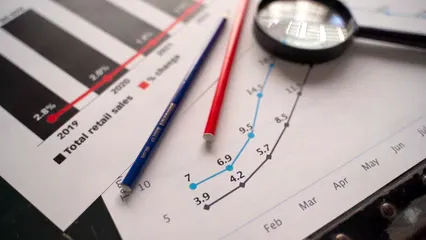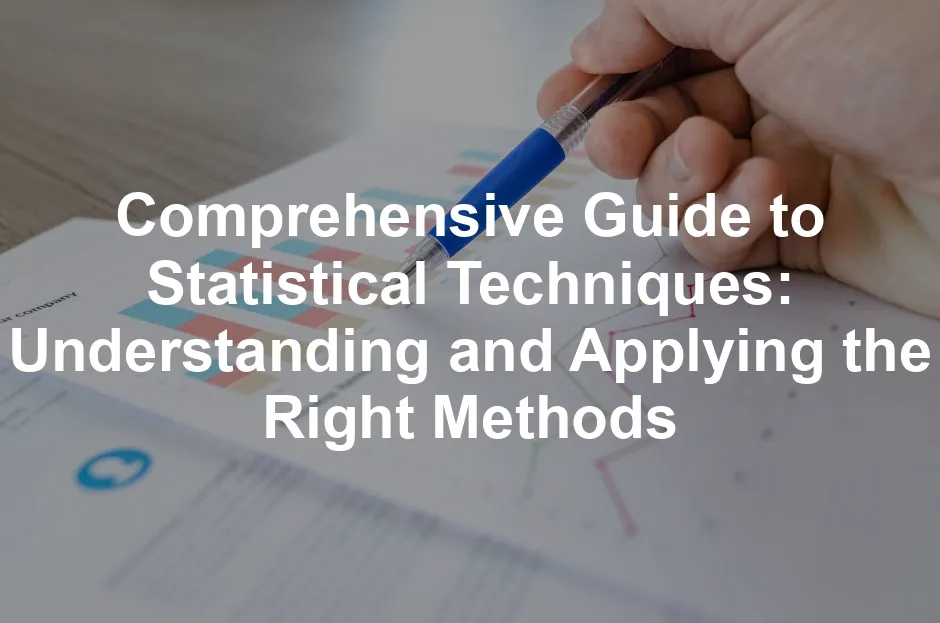Introduction
Statistical techniques play a vital role in data analysis. They help us make sense of data and extract meaningful insights. In today’s data-driven world, statistical literacy is essential across many fields, including business, healthcare, and social sciences. This article aims to provide a detailed overview of key statistical techniques to empower your analysis.
If you’re looking to brush up on your statistics knowledge, consider picking up a copy of “Statistics for Dummies” by Deborah J. Rumsey. It’s a friendly guide that takes the dread out of data, making it perfect for both beginners and those looking to refresh their skills.
Summary and Overview
Statistical techniques are methods used to analyze and interpret data. They allow researchers to draw conclusions and make predictions based on empirical evidence. There are two main categories: descriptive and inferential statistics.
Descriptive statistics summarize data, providing insights into its main features. This includes measures like mean, median, and mode. Inferential statistics, on the other hand, involve making predictions or inferences about a population based on a sample.
In this article, we will cover various statistical techniques that can enhance your decision-making. You’ll learn how to choose the right approach based on your data type and research objectives. Mastering these techniques is crucial for effective data-driven strategies and outcomes.
Looking for a deeper dive into statistics? Check out “Naked Statistics: Stripping the Dread from the Data” by Charles Wheelan. This book is perfect for those who want to grasp the concepts without getting bogged down in complex mathematics.
Understanding Statistical Techniques
What are Statistical Techniques?
Statistical techniques are methods used to collect, analyze, and interpret data. They provide a framework for understanding complex information and drawing conclusions. By applying these techniques, researchers can identify trends, relationships, and patterns in data.
These methods are widely applicable in various fields. In business, they help in market analysis and forecasting sales. In healthcare, they assist in clinical trials and patient outcome studies. Social sciences utilize statistical techniques to understand behavioral patterns and social phenomena.
Overall, statistical techniques are essential tools for researchers and professionals. They enable effective analysis, leading to informed decisions and improved outcomes. Understanding these methods empowers you to navigate the data landscape confidently.
If you’re working with data, a solid foundation in statistical software is essential. Consider using Graphing Calculators or R Programming Language for your analyses.
Types of Statistical Techniques
Understanding statistical techniques is vital for effective data analysis. The two primary categories are descriptive and inferential statistics.
Descriptive statistics summarize and describe data. They provide insights into the main features of a dataset. This includes measures like the mean, median, and mode. For instance, you might use these to present survey results or summarize test scores.
Inferential statistics go a step further. They allow us to make predictions or inferences about a larger population based on a sample. This includes techniques like hypothesis testing and regression analysis. For example, you can determine if a new drug is effective by testing a sample group and inferring results for the broader population.
Choosing the right technique is crucial. Your research questions dictate which statistical method to use. If you’re only describing data, descriptive statistics suffice. However, if you aim to make predictions or test theories, inferential methods are necessary. Understanding this distinction can lead to more accurate results and insights.

Main Statistical Techniques
Descriptive Statistics
Measures of Central Tendency
Measures of central tendency provide a summary of data points. The three primary measures are mean, median, and mode.
Mean: This is the average of all data points. It’s useful when data is normally distributed. However, it can be skewed by outliers. For a deeper understanding of how mean is defined in statistics, check out what does mean identically distributed in statistics.
Median: This is the middle value when data is sorted. It is ideal when you have outliers, as it isn’t affected by extreme values. For example, the statistics poland median salary 2024 can illustrate this measure.
Mode: The most frequently occurring value in a dataset. It’s helpful for categorical data where you want to know the most common category.
Deciding which measure to use depends on your data’s characteristics. For skewed distributions, opt for the median. For normally distributed data, the mean works well.

To further enhance your statistical skills, consider “The Art of Statistics: Learning from Data” by David Spiegelhalter. This book will guide you through the essential concepts, making it easier to apply statistics in real-world scenarios.
Measures of Dispersion
Measures of dispersion help us understand data variability. Key measures include range, variance, and standard deviation.
Range: This is the difference between the highest and lowest values. It gives a quick sense of spread but can be misleading with outliers. For a practical example, you can refer to orange county ca crime statistics.
Variance: This measures how far each number in the dataset is from the mean. A higher variance indicates more spread in data.
Standard Deviation: This is the square root of variance. It provides a clearer picture of data spread in the same units as the original data.
Understanding these measures is crucial for interpreting data distribution. They reveal if your data points cluster closely or spread out widely, impacting your analysis’s reliability.

Inferential Statistics
Hypothesis Testing
Hypothesis testing is a core concept in inferential statistics. It involves two hypotheses: the null hypothesis and the alternative hypothesis.
Null Hypothesis (H0): This states that there is no effect or difference. It serves as the default assumption.
Alternative Hypothesis (H1): This proposes that there is an effect or difference.
The p-value plays a crucial role in this process. It indicates the probability of observing your results if the null hypothesis is true. A low p-value (typically less than 0.05) suggests that you can reject the null hypothesis. This means your findings are statistically significant and unlikely due to random chance. Understanding these concepts helps in making informed decisions based on data. For a comprehensive guide on hypothesis testing, refer to statistics hypothesis testing cheat sheet.

To dig deeper into statistical inference, consider the book “Discovering Statistics Using IBM SPSS Statistics” by Andy Field. This book is a fantastic resource for learning how to apply statistical techniques using one of the most popular software packages.
t-Tests
t-Tests are statistical methods that compare means between groups. There are two main types: independent and paired t-tests.
Independent t-test is suitable when comparing means from two different groups. For instance, you can use it to analyze test scores between male and female students. If you find a p-value of less than 0.05, it suggests a significant difference in performance.
Paired t-test, on the other hand, compares means from the same group at different times. Think about measuring the weight of participants before and after a diet program. Again, a p-value below 0.05 indicates a significant change.
Choosing the right t-test depends on your data structure. If your groups are unrelated, opt for the independent t-test. Use the paired t-test when comparing related samples.

Analysis of Variance (ANOVA)
ANOVA, or Analysis of Variance, helps test differences among three or more group means. There are two types: one-way and two-way ANOVA.
One-way ANOVA assesses the impact of a single factor on a dependent variable. For example, you might use it to compare the test scores of students from different majors. A significant F-value indicates that at least one group mean differs.
Two-way ANOVA considers two factors simultaneously. For instance, you could examine how both study method and gender affect test scores. This method not only checks for main effects but also interaction effects.
Interpreting the results involves looking at the F-statistic and associated p-value. If the p-value is less than 0.05, your findings are statistically significant, indicating noteworthy differences among group means.

Regression Analysis
Regression analysis predicts outcomes based on one or more independent variables. It comes in two forms: simple and multiple regression.
Simple regression examines the relationship between one independent variable and a dependent variable. For example, you might predict a student’s GPA based on hours spent studying.
Multiple regression involves two or more independent variables. This approach allows for a more comprehensive model. For instance, you could predict GPA using hours studied, class attendance, and previous grades. For a detailed guide on regression analysis, see understanding regression analysis.
Both techniques help identify trends and make predictions. By understanding the relationships between variables, you can better inform decisions in various contexts.

Enhance your understanding of data analysis further with a copy of “Practical Statistics for Data Scientists: 50 Essential Concepts” by Peter Bruce. This book is a great resource for understanding the practical applications of statistical methods in data science.
Non-parametric Techniques
Non-parametric techniques are valuable when data doesn’t meet parametric assumptions. These methods are often used with ordinal or nominal data.
For instance, if your data is not normally distributed, consider using non-parametric tests like the Mann-Whitney U test or the Kruskal-Wallis test. The Mann-Whitney U test compares two independent groups, while the Kruskal-Wallis test extends this to three or more groups.
These techniques are robust against outliers and don’t require as strict assumptions as parametric tests. Use them when sample sizes are small or when data is skewed. They provide a reliable alternative for analyzing data, ensuring valid results.

Correlation Analysis
Pearson and Spearman Correlation
Correlation coefficients measure the strength and direction of relationships between two variables. The values range from -1 to +1, indicating perfect negative or positive relationships, respectively. A coefficient of 0 suggests no correlation at all.
Pearson correlation assesses linear relationships and is suitable for continuous data that is normally distributed. For example, it can reveal how study hours relate to exam scores. On the other hand, Spearman correlation evaluates ranked data and is used for non-parametric scenarios. It’s ideal when data does not meet normality assumptions.
In summary, use Pearson when data is linear and normally distributed. Opt for Spearman when dealing with ordinal data or when normality assumptions are violated. Understanding these distinctions helps in selecting the appropriate method for analysis.

Advanced Statistical Techniques
Factor Analysis
Factor analysis is a technique used to reduce the number of variables in a dataset. It simplifies data by identifying underlying relationships among variables. This method is particularly useful when dealing with large datasets containing many interrelated variables.
It’s often employed in surveys to uncover latent constructs, such as customer satisfaction. You might use factor analysis when you have multiple measures of a concept and want to identify the core factors that represent them.
To perform factor analysis, ensure you have a sufficient sample size to achieve reliable results. This technique can help streamline your data analysis and make your findings clearer.

Cluster Analysis
Cluster analysis groups similar data points together based on their characteristics. It’s widely used in market segmentation, where businesses want to identify distinct customer groups.
Several methodologies are available, such as K-means and hierarchical clustering. K-means involves partitioning data into K clusters based on their features, while hierarchical clustering creates a tree-like representation of clusters.
Choosing the right method depends on your data and what you aim to achieve. For instance, K-means is efficient for large datasets, while hierarchical clustering provides a more detailed view of relationships. Understanding these methods will enhance your data segmentation efforts.

Conclusion
Understanding and applying the right statistical techniques is crucial for effective data analysis. These methods provide insights that guide informed decisions. Whether analyzing relationships or reducing data complexity, mastering these techniques enhances your analytical skills.
As you engage with data, consider expanding your statistical knowledge. This will improve your ability to interpret results and make data-driven decisions confidently.
For those interested in the ethical implications of data, I recommend “How to Measure Anything: Finding the Value of ‘Intangibles’ in Business” by Douglas W. Hubbard. This book will challenge your thinking about measurement and decision-making.
FAQs
What is the difference between descriptive and inferential statistics?
Descriptive statistics summarize data to reveal its main characteristics. They provide information such as averages, ranges, and distributions. For example, if you conduct a survey on student grades, descriptive statistics would help you present the average score or the most common grade. Inferential statistics, however, allow us to make predictions or generalizations about a larger population based on sample data. For instance, if you survey a small group of students, you might use inferential statistics to estimate the average grade of all students in a school. This distinction is crucial for understanding how to interpret results from your analyses effectively.
When should I use non-parametric statistical tests?
Non-parametric tests are ideal when your data does not meet the assumptions required for parametric tests. You might choose these tests when your data is ordinal or when the sample size is small. For example, if you’re comparing scores from a survey that ranks preferences, non-parametric tests like the Mann-Whitney U test are appropriate. Another scenario is when your data is skewed or contains outliers. In such cases, non-parametric tests like the Kruskal-Wallis test provide a more reliable analysis without being influenced by extreme values. Understanding when to use these tests helps ensure valid results.
How do I choose the right statistical technique for my data?
Selecting the right statistical technique hinges on several factors. First, consider the type of data you have: Is it categorical, ordinal, or continuous? For categorical data, use tests like the Chi-square test. For continuous data, t-tests or ANOVA might be more appropriate. Next, think about your research question. Are you comparing groups, or looking for relationships between variables? Use t-tests for comparing two groups and regression analysis for exploring relationships. Lastly, understand the assumptions of each test, such as normality and variance. This knowledge will guide you in choosing the most suitable technique for your analysis.
What are common mistakes in statistical analysis?
Several pitfalls can occur during statistical analysis. One common mistake is neglecting to check for normality in your data. If data doesn’t follow a normal distribution, using a parametric test can lead to invalid conclusions. Another frequent error is not accounting for sample size. Small samples can produce unreliable results, so it’s essential to ensure your sample is sufficiently large. Overlooking the importance of effect size is also a mistake; knowing whether your findings are statistically significant is not enough. Effect sizes give context to how meaningful those results are, helping you better interpret your data.
How can I improve my statistical analysis skills?
Improving your statistical analysis skills involves practice and education. Start with online courses on platforms like Coursera or edX, which offer courses tailored to various skill levels. Books on statistics also provide valuable insights; consider titles that focus on practical applications. Using statistical software like R or SPSS can enhance your skills. These tools allow you to apply techniques and visualize data effectively. Additionally, participating in forums and discussion groups can expose you to real-world problems and solutions, boosting your learning experience. Engage with others in the field to share knowledge and ask questions, as collaboration often leads to deeper understanding.
Please let us know what you think about our content by leaving a comment down below!
Thank you for reading till here 🙂
All images from Pexels




